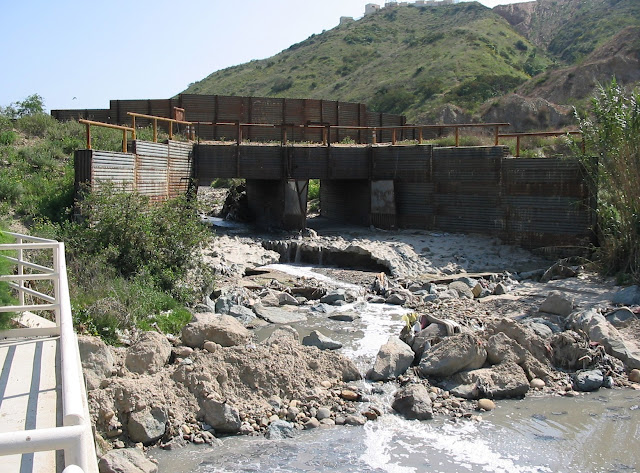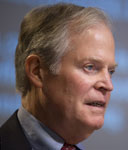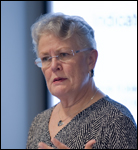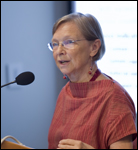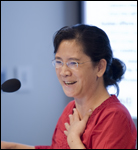Showing posts from category *Blog Columns.
-
Circle of Blue Launches ‘Choke Point: U.S.’ Series Examining Intersection of Water and Energy Resources
›Speaking yesterday at the Wilson Center, Circle of Blue Senior Editor and New York Times reporter Keith Schneider called his organization’s latest project, reporting on the intersection of finite water resources and growing demand for energy around the world, one of the most important stories of his career. First in the series is Choke Point: U.S.:
For as long as the United States has been a nation the central idea guiding energy development is to generate as much as the energy sector is capable of producing. In every way imaginable, though, the 21st century is testing the soundness of that principle. A number of environmental, economic, and political impediments lie in the path to large increases in American energy production.
For more check out Circle of Blue’s full feature as well their multimedia section, with infographics illustrating water regulations and power generation type by state, North Dakota’s remarkable rise to “domestic oil royalty,” and video interviews with residents and experts from around the country (including the Wilson Center’s Jennifer Turner, on China).
None, though, is more significant than the nation’s steadily diminishing reserve of fresh water. The place where rising energy demand collides with declining water supplies is a national choke point that the United States has barely begun to address, and certainly isn’t close to resolving.
Beyond the United States, Circle of Blue and the Wilson Center’s China Environment Forum also hope to start-up a “Choke Point: China” but are still seeking funding.
Image Credit: Graphic courtesy of Ball State University graduate student, Mark Townsend, and data compiled by Circle of Blue’s Aubrey Ann Parker and Andrea Hart. -
Alex Evans on Resource Scarcity and Global Consumption
› “Why should we be concerned with scarcity issues?” asks New York University’s Alex Evans. Beyond general population growth, there is also an expanding global middle class that is shifting to more Western diets and consuming more energy, he explains. The net result is that demand for food, water, oil, and land is outpacing supply. These scarcity issues should be grouped together, argues Evans, because you can’t address one without affecting the others.
“Why should we be concerned with scarcity issues?” asks New York University’s Alex Evans. Beyond general population growth, there is also an expanding global middle class that is shifting to more Western diets and consuming more energy, he explains. The net result is that demand for food, water, oil, and land is outpacing supply. These scarcity issues should be grouped together, argues Evans, because you can’t address one without affecting the others.
The “Pop Audio” series offers brief clips from ECSP’s conversations with experts around the world, sharing analysis and promoting dialogue on population-related issues. Also available on iTunes. -
Environmental Security Along the U.S.-Mexico Border
›
In 2005, the U.S. Department of Homeland Security (DHS) began the construction of a massive earthen, concrete, and metal security barrier along much of the U.S.-Mexico border, from the Pacific Ocean to the Gulf of Mexico.
Framing it as an issue of national security, DHS used provisions in the Real ID Act to waive environmental laws and citizen review for the controversial infrastructure project.
Unfortunately in Imperial Beach, California – my corner of the U.S.-Mexico border – the poorly engineered barrier has caused serious environmental mishaps and damage. In 2009 the Voice of San Diego reported that DHS circumvented numerous local and state laws in the course the barrier’s construction:Were it anyone else’s project, state regulators would’ve required irrigation to ensure that plants grew. But the federal government is responsible for the $59 million effort to complete and reinforce 3.5 miles of border fence separating San Diego and Tijuana. The Department of Homeland Security exempted itself from eight federal laws and any related state laws that would have regulated the project’s environmental impacts.
The Voice goes on to report that state water regulators also have no jurisdiction over the project since it has been exempted from the federal Clean Water Act.
“They did better engineering in 8th century China,” said Joe Sharkey of The New York Times, whom I took on a tour of the border, about the massive amphitheater of dirt that DHS dumped in Smuggler’s Gulch a few miles from the Pacific.
Ironically, while DHS has focused its efforts on the massive earthen and concrete wall, the agency has virtually ignored the tidal wave of polluted sewage water and garbage that flows across this section of the U.S.-Mexico border, a problem that makes the very people charged with safeguarding our security – border patrol agents and even Navy Seals – often unable to carry out their mission.
Over the past 20 years, border patrol agents have become ill from contact with the region’s polluted rivers, as well as the Pacific Ocean. In the Calexico-Mexicali region, border patrol agents worked directly with the Calexico New River Committee to clean up the New River – a drainage canal turned toxic hot spot.
Navy Seals based in Coronado, California, about 10 miles north of the U.S.-Mexico border, train in an area of the ocean that is directly impacted by polluted water flowing across the border from Mexico, bypassing the vaunted concrete and metal border barrier.
The organization I run, WiLDCOAST, is now working with U.S. agencies such as the International Boundary and Water Commission and the Environmental Protection Agency along with agencies in Mexico (e.g., CONANGUA and the state of Baja California) to reduce the threats to our military personnel and federal employees as well as border residents from cross-boundary pollution.
This cooperation has required a significant investment on the part of both the Mexican and U.S. governments in developing real solutions to our environmental security crisis on the border. Unfortunately the massive Berlin Wall-style barrier on our southern border is of little assistance in this effort.
Solving complex transboundary issues sometimes requires ignoring the cacophony of politics from distant capitals and instead working on the ground with colleagues from both nations who are experts in their shared geography. It appears the Obama administration is now slowly trying to repair some of the damage done to local communities, the cross-boundary relationship with Mexico, and our fragile shared environment.
But much more work and investment is needed to safeguard those we entrust to protect our security along the borderlands, as well as the residents of the region, from pollution that ignores international divisions and concrete walls. We must remember not only the national security component of our border-strengthening efforts but also the effect on human and environmental security as well.
Serge Dedina is the executive director of WiLDCOAST. He grew up and still lives on the U.S.-Mexico border in Imperial Beach, California. He is the author of Saving the Gray Whale and the forthcoming Wild Sea: Eco-Wars and Surf Stories From the Coast of the Californias.
Sources: Defenders of Wildlife, Environmental Protection Agency, University of Arizona, Voice of San Diego, WiLDCOAST.
Photo Credit: Serge Dedina. -
Joseph Speidel on Population, the Environment, and Growth
› “If we could do something about unintended pregnancies – which are about 80 million a year – we could dramatically reduce population growth,” and reduce pressure on the environment, says Joseph Speidel in this short analysis from the Environmental Change and Security Program. Speidel discusses the connections between population, health, and environment issues, and offers solutions for the way forward.
“If we could do something about unintended pregnancies – which are about 80 million a year – we could dramatically reduce population growth,” and reduce pressure on the environment, says Joseph Speidel in this short analysis from the Environmental Change and Security Program. Speidel discusses the connections between population, health, and environment issues, and offers solutions for the way forward.
The “Pop Audio” series offers brief clips from ECSP’s conversations with experts around the world, sharing analysis and promoting dialogue on population-related issues. Also available on iTunes. -
Improving Monitoring, Transparency, and Accountability for Maternal, Newborn, and Child Health
›“There is a knowledge gap between global targets and locally owned goals,” said Sallie Craig Huber, global lead for results management at Management Sciences for Health (MSH). The seventh meeting of the “Advancing Policy Dialogue on Maternal Health” series – cosponsored by the Global Health Council, MSH, and PATH – comes at a critical time as world leaders meet next week at the high-level, plenary UN Summit to review progress toward the Millennium Development Goals (MDGs).
Panelists Marge Koblinsky, senior technical advisor, John Snow Inc., Ellen Starbird, deputy director, U.S. Agency for International Development, and Monique Widyono, program officer of PATH, discussed strategies for improving maternal health evaluation methods while balancing the interests of donors and beneficiaries.
Maternal Health Indicators: Contact vs. Context
“Skilled birth attendants [have] become the strategy [for improving maternal mortality rates], but one size does not fit all,” said Koblinsky. The proportion of births attended by skilled birth attendants is a key maternal health indicator; however, it is not sufficient and says little about what the attendants actually did during the birth.
Koblinsky demonstrated how other indicators such as near-miss morbidity, rates of cesarean section, and contraceptive prevalence rates (CPR) are better aligned with maternal mortality outcomes. “CPR is much more closely linked with the outcome we desire as [contraception] reduces pregnancies for those at higher risk and reduces unwanted births and unsafe abortions,” said Koblinsky.
“Are the present benchmarks enough?” asked Koblinsky. “The answer is no….Indicators based on contact with skilled birth attendants focuses attention on contact, not on the quality of care or event context.”
Qualitative Data Is Necessary
“When we talk about monitoring and evaluation, transparency and accountability, it’s really critical to engage [in a discussion] on how we gauge progress,” said Widyono. In the field, “collection of data varies widely and depends on the capacity of those collecting, aggregating, and analyzing the information,” said Widyono. Such inconsistencies demand increased investment in local research capacity and qualitative analysis.
Such engagement also provides an opportunity for feedback. This “qualitative data helps to reinforce, illuminate, and deepen the understanding of what this quantitative data is showing on the ground,” said Widyono. Moving forward, policymakers, donors, and program managers will need to find a balance between these two sets of data and work together to galvanize action.
“There is a lack of attention paid to developing local, sustainable research capacity,” said Widyono. “We have an obligation to build local research capacity and disseminate findings in collaboration with the people who are going to be affected by this data,” she said.
Innovation and Research
“We really need to think about monitoring and evaluation and research and innovation as a continuum,” said Starbird. “They reinforce each other and play different roles in helping us understand what makes programs work or why they are not working.”
“We have a myriad of indicators that we expect people to monitor, collect data for, and report back to headquarters in a way that has not given countries and programs the freedom to be country-specific,” said Starbird. Therefore, “one of the goals is to minimize the reporting burden and better coordinate around indicator definition with other donors,” she said.
In order to strengthen “M&E;” for maternal health, Starbird called for new indicators as well as new ways of thinking about data analysis. “Having a results framework is really important to do good monitoring and evaluation,” she said. Evaluating the relationship between inputs, outputs, outcomes, and impacts requires a wide range of data resources so we can “get under the numbers” and determine what needs to be improved, she said.
“It’s really important to have realistic goals, otherwise it’s difficult to put programs into place and get where we want to go,” said Starbird. She said that MDG 5.B, which calls for universal access to reproductive health, “is great, but there’s never going to be universal access to reproductive health. If we really want to make progress we need to define something that is achievable and is something we can come together around.”
In conclusion, it is necessary to provide “countries with the room to do what needs to be done locally, so we can better understand these concepts rather than imposing indicators on everybody,” said Starbird. -
Climate-Security Linkages Lost in Translation
›A recent news story summarizing some interesting research by Halvard Buhaug carried the headline “Civil war in Africa has no link to climate change.” This is unfortunate because there’s nothing in Buhaug’s results, which were published in the Proceedings of the National Academy of Sciences, to support that conclusion.
In fact, the possibility that climate change might trigger conflict remains very real. Understanding why the headline writers got it wrong will help us better meet the growing demand for usable information about climate-conflict linkages.
First, the headline writer made a simple mistake by translating Buhaug’s modest model results — that under certain specifications climate variables were not statistically significant — into a much stronger causal conclusion: that climate is unrelated to conflict. A more responsible summary is that the historical relationship between climate and conflict depends on how the model is specified. But this is harder to squeeze into a headline — and much less likely to lure distracted online readers.
Buhaug tests 11 different models, but none of the 11 corresponds to what I would consider the emerging view on how climate shapes conflict. Using Miguel et al. (2004) as a reasonable representation of this view, and supported by other studies, there seems to be a strong likelihood that climatic shocks — due to their negative impacts on livelihoods — increase the likelihood that high-intensity civil wars will break out. None of Buhaug’s 11 models tested that view precisely.
If we are going to make progress as a community, we need to be specific about theoretically informed causal mechanisms. Our case studies and statistical tests should promote comparable results, around a discrete number of relevant mechanisms.
Second, a more profound confusion reflected in the headline concerns the term “climate change.” Buhaug’s research did not look at climate change at all, but rather historical climate variability. Variability of past climate is surely relevant to understanding the possible impacts of climate change, but there’s no way that, by itself, it can answer the question headline writers and policymakers want answered: Will climate change spark more conflict? For that we need to engage in a much richer combination of scenario analysis and model testing than we have done so far.
We are in a period in which climate change assessments have become highly politicized and climate politics are enormously contentious. The post-Copenhagen agenda for coming to grips with mitigation and adaptation remains primitive and unclear. Under these circumstances, we need to work extra hard to make sure that our research adds clarity and does not fan the flames of confusion. Buhaug’s paper is a good model in this regard, but the media coverage does not reflect its complexity. (Editor’s note: A few outlets – Nature, and TIME’s Ecocentric blog – did compare the clashing conclusions of Buhaug’s work and an earlier PNAS paper by Marshall Burke.)
The stakes are high. This isn’t a “normal” case of having trouble translating nuanced science into accessible news coverage. There is a gigantic disinformation machine with a well-funded cadre of “confusionistas” actively distorting and misrepresenting climate science. Scientists need to make it harder for them to succeed, not easier.
Here’s how I would characterize what we know and we are trying to learn:1) Economic deprivation almost certainly heightens the risk of internal war.
To understand how climate change might affect future conflict, we need to know much more. We need to understand how changing climate patterns interact with year-to-year variability to affect deprivation and shocks. We need to construct plausible socioeconomic scenarios of change to enable us to explore how the dynamics of climate, economics, demography, and politics will interact and unfold to shape conflict risk.
2) Economic shocks, as a form of deprivation, almost certainly heighten the risk of internal war.
3) Sharp declines in rainfall, compared to average, almost certainly generate economic shocks and deprivation.
4) Therefore, we are almost certain that sharp declines in rainfall raise the risk of internal war.
The same scenarios that generate future climate change also typically assume high levels of economic growth in Africa and other developing regions. If development is consistent with these projections, the risk of conflict will lessen over time as economies develop and democratic institutions spread.
To say something credible about climate change and conflict, we need to be able to articulate future pathways of economics and politics, because we know these will have a major impact on conflict in addition to climate change. Since we currently lack this ability, we must build it.Marc Levy is deputy director of the Center for International Earth Science Information Network (CIESIN), a research and data center of the Earth Institute of Columbia University.
Photo Credit: “KE139S11 World Bank” courtesy of flickr user World Bank Photo Collection.
-
New World Bank Report on Land Grabs Is a Dud
›After months of delays and false starts, and a tantalizing partial leak to the Financial Times earlier this summer, the much-ballyhooed World Bank report on large-scale land acquisitions has finally arrived.
-
Saleem Ali at TEDxUVM on Environmental Peacemaking
›“The use of the term ‘peace’ is in many circles still considered taboo, because immediately people think you are talking about something that is utopian,” said University of Vermont Professor Saleem Ali at a recent TEDx event on sustainability. “But I’m here to tell you that peace is pragmatic. Peace is possible.”
Ali points out the value of peace to every sector of society and, using an example from Ecuador and Peru, argues for the utility of the environment as a peacemaker. Other longstanding conflict areas like Cyprus, Iraq, Israel, and Korea are also ripe for environmental peacebuilding efforts, he says.
Professor Ali has written for The New Security Beat before on the strengths and weaknesses of viewing conservation and sustainability efforts through a strictly security lens. He points out that environmentalists must tread a fine line when assigning causality between the environment and conflict, but even when natural resources or climate are not central to a conflict, environmental peacebuilding can still play a role in creating shared ground (sometimes literally) between combatants.
“Treasures of the Earth,” Ali’s latest book, examines the thorny subject of how best to balance resource extraction in developing countries with long-term sustainability. Recent examples, such as Angola and Liberia’s blood diamonds, the DRC’s conflict minerals, and concerns over Afghanistan’s potential reserves have shown the difficulty in striking that balance.
“Ultimately, conflict trumps everything else” in terms of what we ought to be concerned with, Ali argues, and therefore, anyone, no matter their profession or capacity, should keep the pursuit of peace in mind – and all options on the table – when making decisions that affect others.



